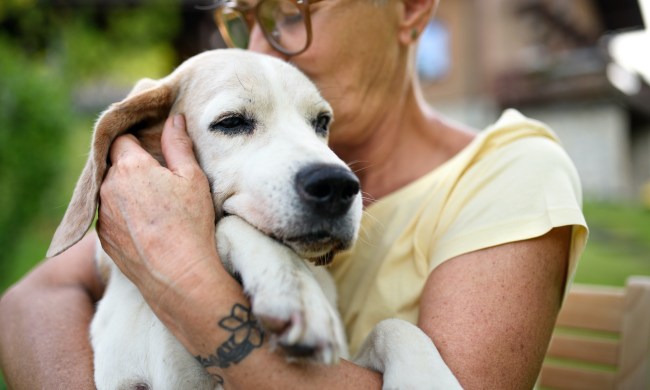There are so many reasons to love springtime, whether you’re a human or a dog. From the beautiful blooms and adorable baby animals — the longer days and warmer weather are only the beginning! Spring is the perfect time to plan an outdoor activity with your furry friend, though it’s always important to be mindful of springtime hazards for dogs, like bee stings.
Seeing your dog stung by a bee is never fun, but you’ll be glad to know that it’s rarely a big deal. Most dogs experience no symptoms besides minor pain and swelling, but it’s always good to know what to keep an eye out for. Your eagle-eyed view could be the difference between a minor injury and a major, life-threatening reaction.
How can you tell if your dog was stung by a bee?

Of course, the first thing you’ll notice if your dog is stung by a bee is a sudden, painful reaction. They may yelp, jump, or make a sudden movement, but you may also need to use context clues if you didn’t see the bee itself. Is your dog suddenly licking their paws? Was your dog sniffing a flower bush or digging in the grass? These are places that bees frequently visit where your pup is likely to encounter them.
Other immediate signs of a bee sting on a dog include drooling, pawing, and licking at the sting site. Swelling, tenderness, and redness can also come on immediately, so keep an eye out.
What should dog owners do if their dog is stung by a bee?

As VCA Animal Hospital notes, bees are the only insects that leave their stinger behind after stinging a victim. To ensure that you’re dealing with a bee sting and not a bite or sting from another insect, try to locate the painful area on your dog, then look for a stinger. Most of the time, dogs are stung on the paws, nose, or face, but they could get stung anywhere.
Your most important task following a dog’s bee sting is identifying signs of an allergic reaction (more on that below). In the meantime, look for the stinger or the insect, and keep your dog as calm as possible.
Is it safe to remove the stinger if it’s still in the wound?

Once you’ve found the bee’s stinger, it’s essential to remove it as soon as possible. This is because bee stingers contain venom, which causes swelling and other reactions. The longer the stinger stays in your dog’s skin, the more venom is pumped into your dog’s body. While this won’t make a difference for dogs that are allergic to bee venom, it can help keep minor symptoms like swelling and pain to a minimum.
To remove the stinger, VCA Hospitals recommends scraping it out with a small, flat object like a credit card. Try not to use tweezers unless absolutely necessary, as squeezing the stinger could cause more venom to come out as you’re removing it.
When does a dog need to visit the vet for a bee sting?

It’s never a bad idea to let your veterinarian know when your dog has been stung by a bee, especially if this is the first time this has happened. Your vet can remind you of concerning symptoms to look out for, and they can give you the best advice on whether to bring them in or wait it out. While most dog bee stings are not an emergency, many vets and dog owners prefer to err on the side of caution.
At-home remedies for bee stings

Northeast Veterinary Referral Hospital advises pet parents not to give their dogs any over-the-counter medication, like antihistamines or pain relief, until they’ve consulted with their dog’s veterinarian. Sometimes, Benadryl can help relieve minor symptoms and swelling, but this is not always the right route to take.
Other at-home remedies for bee stings include a cold compress to relieve swelling, a soothing oatmeal bath or baking soda paste, and maintaining hydration. Remember not to let your dog scratch or bite at the area, either.
Can dogs be allergic to bee stings?

Just like humans, some dogs are allergic to the venom that bees secrete when they sting. The severity of the reaction will vary from one individual to the next, but you should contact your veterinarian at your first sign of concern.
Please do not wait, and head to the nearest emergency vet if you notice any of these symptoms of an allergic reaction following a dog’s bee sting:
- Trouble breathing
- Gasping or wheezing
- Pale gums
- Extreme swelling on the neck and face
- Hives anywhere on the body
- Extreme drooling, which may indicate throat swelling
- Vomiting or diarrhea
- Agitation or aggression
- Dizziness or confusion
- Seizures or unconsciousness
It’s startling to see your dog stung by a bee, but these symptoms are even scarier. They can come on within minutes of the sting, so don’t leave your dog unattended if you suspect they have been stung. Veterinary treatment for allergies and anaphylaxis may include IV fluids, antihistamines, steroids, and even epinephrine.
How to avoid bee stings

Of course, the best way to reduce your dog’s risk of a severe reaction to a bee sting is to help them avoid being stung. This can be tricky when bees are busy pollinating vibrant springtime flowers, but just a little mindfulness can make a big difference.
Australia’s Animal Emergency Service recommends brushing up on obedience training and recall so your dog will always come when called. This way, you can teach them to stay out of flowerbeds, keep on proper walking trails, and be near you at all times. You may not be able to avoid every bee out there, but find ways to keep your dog engaged and distracted so they don’t chase, swat, or bite at flying insects.
These tiny pollinators can create a big problem for our furry friends, but just a little planning and thoughtfulness can keep both you and your dog safe from stings this spring. With just a little distance, your pup can see just what fascinating creatures our buzzy yellow friends can be. In fact, some folks even name their dogs after springtime icons like flowers and bumble bees!




